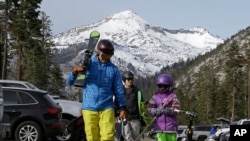The snowpack that's essential for California's water supply is at critically low levels again this year, raising fears of the return of a drought.
On Thursday, researchers from the state's Department of Water Resources headed into the Sierra Nevada to measure water content and snow levels at the Phillips Station near Lake Tahoe. They found the snowpack stood at less than a third of its normal size for the date.
A weekly report released by the U.S. Drought Monitor also shows 44 percent of the state is now considered to be in a moderate drought. That's a dramatic jump from just last week, when the figure was 13 percent.
Spring and summer snowmelt of the Sierra snowpack is a crucial element to California's water supply, recharging reservoirs during the state's dry summer and early fall.
While the current Sierra snowpack is worrisome, officials say, it's not yet time to sound the alarm for another California drought, thanks in part to California having its wettest water year in 122 years in 2017.
California lifted a drought state of emergency less than a year ago, ending a record five-year drought.
But the drought never really seemed to end in some Southern California areas, said Daniel Swain, a climate scientist with the University of California, Los Angeles.
Los Angeles has received only one significant rain in nearly 12 months.
A little farther north, in Ventura and Santa Barbara counties, the lack of rain and the dry vegetation were perfect fuel for a December wildfire that grew to be the largest recorded in state history. When it finally did rain, the scorched earth turned into deadly mudslides.
Roughly half of the state's precipitation falls from December through February. So far, there's been little precipitation in parts of the state, and the forecast is showing little relief and calling for higher temperatures.
The situation looks just as worrisome across much of the West. At the beginning of the year, the snowpack was unusually low across swaths of Colorado, Utah, New Mexico and Arizona.







